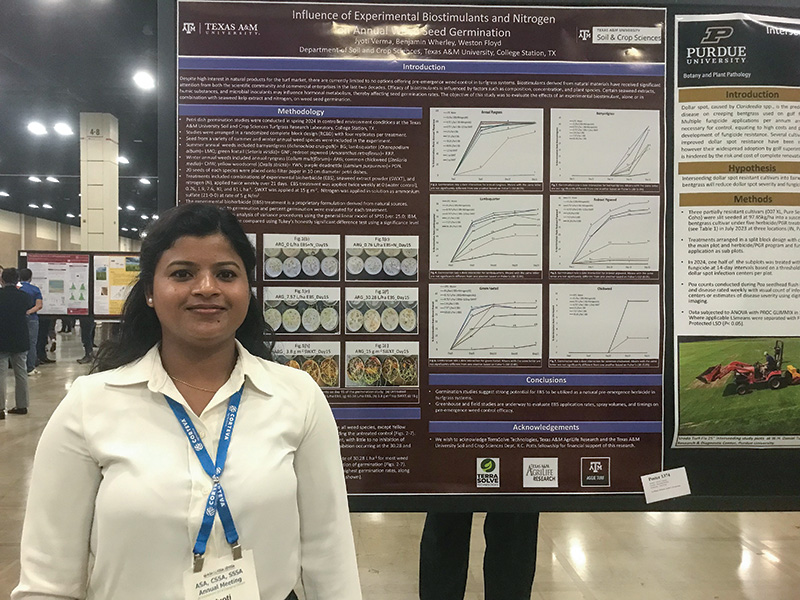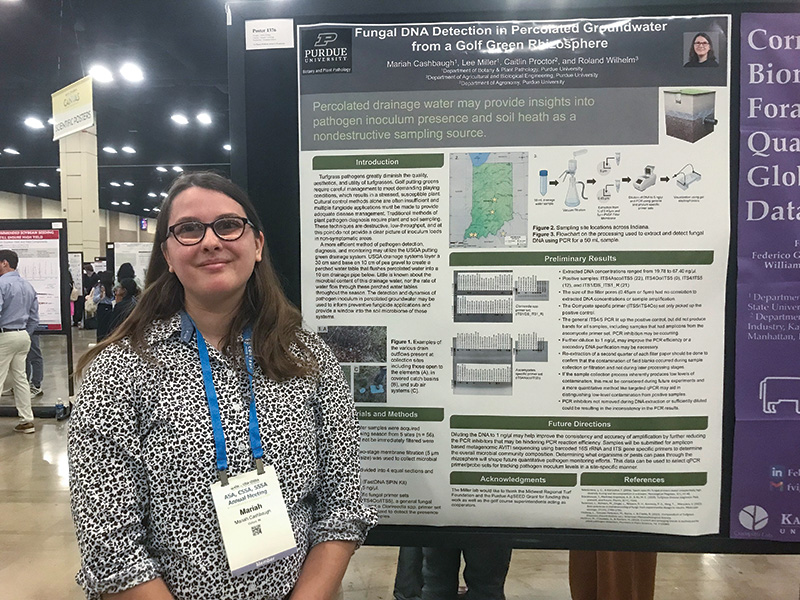
Jyoti Verma. Photos by Darrell J. Pehr
Influence of experimental biostimulants and nitrogen on annual weed seed germination
Despite the high demand for such products, there are currently no effective natural preemergence herbicides available for turfgrass systems. Biostimulants derived from natural materials have received significant attention from the scientific community and commercial enterprises in the last two decades. The efficacy of biostimulants is influenced by factors such as type, concentration and plant species. Certain seaweed extracts, humic substances and microbial inoculants contribute to hormonal metabolism, thereby influencing seed germination rates. This study is evaluating the potential of two experimental biostimulants for potential use as a natural preemergence herbicide. Controlled environment germination trials were conducted across a variety of annual weed species. Five experimental bioherbicide treatment rates (0, 0.068, 0.17, 0.68 and 2.72 gallons per acre/0, 0.64, 1.59, 6.37 and 25.46 liters per hectare), as well as effects of addition of ammonium sulfate (21% nitrogen-0% phosphorus-0% potassium) were evaluated. Over 15-day germination studies, percent germination and days to germination were measured for each treatment.
The results demonstrate a rate-dependent response from the experimental biostimulants, wherein little to no inhibition of germination was observed for any species at the rate of 0.068 gallons per acre, but nearly complete inhibition was observed at the 2.72-gallons-per-acre rate. Subsequent studies will evaluate field applications of this experimental bioherbicide to managed turfgrass systems for fall and spring preemergence herbicide activity.
— Jyoti Verma (jyotiverma@tamu.edu); Benjamin Wherley, Ph.D.; and Weston Floyd, Texas A&M University, College Station

Mariah Cashbaugh
Fungal DNA detection in percolated groundwater from a golf green rhizosphere
Analyzing the microbial biomass collected from percolated groundwater with molecular methods may improve current plant disease diagnostic practices and provide a nondestructive approach for detection and monitoring of plant pathogen inoculum. Putting greens designed with USGA recommendations employ a built-in drainage system that layers an 11.81-inch (30-centimeter) sand base on 3.94 inches (10 centimeters) of pea gravel to create a perched water table, eventually flushing percolated water into interspersed 3.94-inch drainage pipes. Accessible outflows from single greens allow for spatially isolated sampling. Samples (1.69 ounces/50 milliliters) were collected from single green outflows at five sites across Indiana and Kentucky throughout the 2024 growing season. Vacuum-assisted two-stage membrane filtration was used to collect microbial biomass. DNA was extracted from the filters and diluted. Several PCR reactions were conducted utilizing a general fungal primer set, an oomycete-specific primer set, an ascomycete-specific primer set and a Clarireedia spp.-specific primer set.
The ascomycete- and Clarireedia spp.-specific primer sets revealed 22 and 21 positive samples respectively. Only 12 samples were amplified by the general primer set, suggesting that some form of inhibition may be limiting the efficiency of the PCR reaction. No samples were found to contain oomycete DNA. Detection of fungal DNA within the percolated drainage water samples provides valuable insights about the type of microbes that can pass through these systems and how to improve sample processing in the future. Future sequencing efforts and quantitative monitoring of site-specific pathogens will provide a more comprehensive look at the spatial and temporal dynamics of inoculum, allowing for the development of enhanced management strategies.
— Mariah Cashbaugh (mcashbau@purdue.edu); Gerald L. Miller, Ph.D.; Roland C. Wilhelm, Ph.D.; and Caitlin Proctor, Ph.D.; Purdue University, West Lafayette, Ind.
Darrell J. Pehr (dpehr@gcsaa.org) is GCM’s science editor.